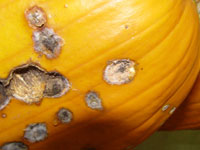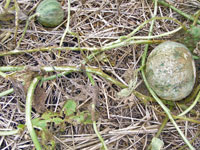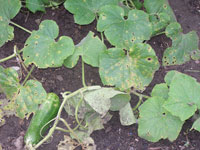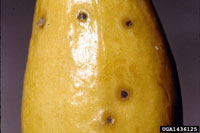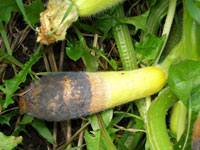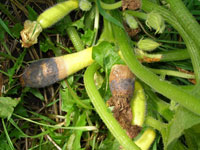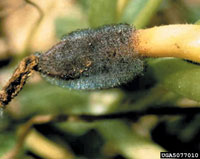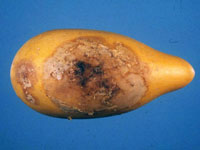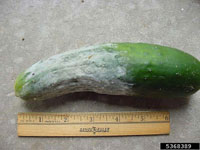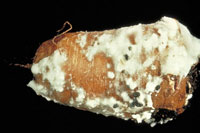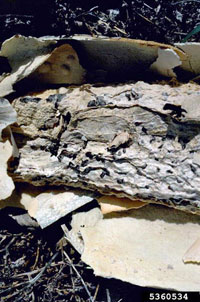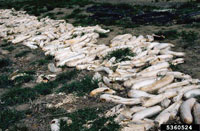Extension > Garden > Diagnose a problem > What's wrong with my plant? > Vegetable > Cucumber > Rotten fruit
Cucumber > Fruit > Rotten fruit
1 of 6
Anthracnose
Colletotrichum obriculare
- Circular sunken dark spots on fruit, salmon colored spores form in the center when wet
- Somewhat circular dry brown leaf spots form near veins
- Center of leaf spot often falls out, leaves appear ‘shot hole’
- Commonly appears mid to late season
- Also commonly infects melons and pumpkin
- More information on Anthracnose
2 of 6
Scab
Cladosporium cucumerinum
- Cucumber, summer squash, zucchini, and pumpkin have sunken fruit spots are covered with greenish black velvety fungal growth
- Winter squash have raised corky areas around fruit infections, internal rot varies depending on resistance of variety
- Irregular gray leaf spot with a yellow halo
- Center of leaf spot falls out, leaves look shot holed or ragged
- Watermelon is very resistant
- More information on Scab
3 of 6
Choanephora Rot
Choanephora cucurbitarum
- Blossom end of squash is soft, rotted and covered in fluffy purplish black fungal growth
- Flowers are covered with first white then purplish black fungal growth
- Occurs after wet weather
- Most common in squash
- More information on Choanephora Rot
4 of 6
Gummy Stem Blight and Black Rot
Didymella bryoniae
- Fruit rot initially looks water soaked and eventually turns completely black
- Tiny black dots can be seen in fruit infections
- Fruit infection often starts on the side of the fruit touching the soil
- Fruit often collapse due to other rotting organisms
- Leaf symptoms vary from browning at leaf edges and between veins to circular tan to brown spots
- Yellow halos may occur around leaf spots and older spots are often dry and cracked
- Tan lesion on stems, often with black spots and dark gummy exudate
- More information on Gummy Stem Blight and Black Rot
5 of 6
Phytophthora Blight
Phytophthora capsici
- Fruit develop soft, water-soaked lesions which expand to large sections of the fruit
- Infected fruit are soft, easily punctured and often collapse
- Infected fruit are covered with white fungal growth
- Large irregular brown spots on leaves
- Stem and leaf petiole lesions are light to dark brown, water soaked and irregular
- The entire plant may collapse if root and crown rot occurs
- More information on Phytophthora Blight
6 of 6
White Mold
Sclerotinia sclerotiorum
- Fruit becomes rotted and watery
- White cottony mold on squash
- Small hard, black raisin like fungal structures embedded in cottony mold
- Most common on pumpkin and some winter squash
- More information on White Mold



